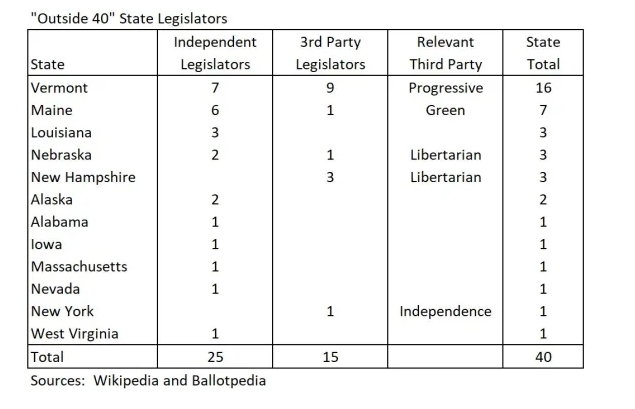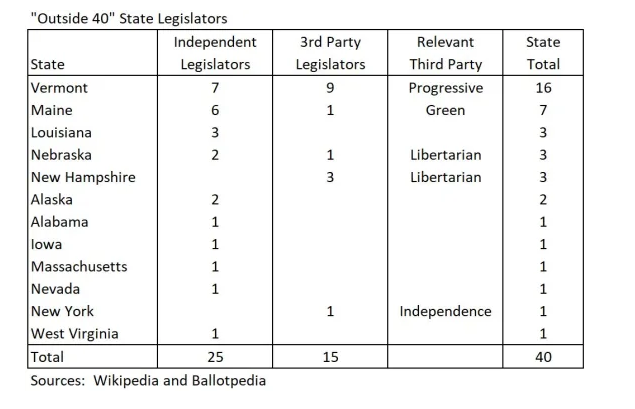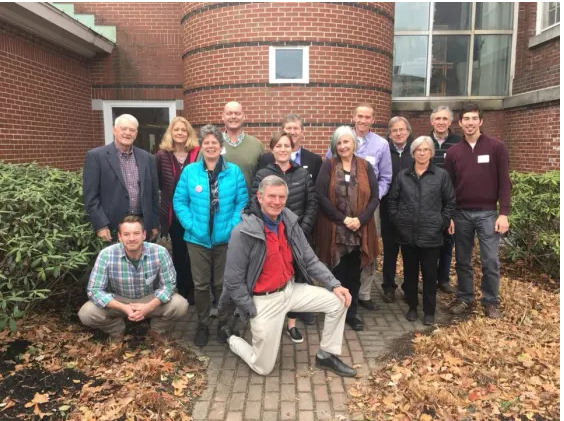INCREDIBLE: Third Party, Independent Representation Up 40% Since 2014

Voter distaste for both the Democratic Party and GOP seems to be at an all-time high. But candidate success outside the major parties remains elusive in Washington.
All 435 members in the U.S. House of Representatives are Democrats or Republicans. Across the Capitol, there are two of 100 senators with “(I)” after their names -- Sen. Bernie Sanders of Vermont and Sen. Angus King of Maine.
But wait, there is another pool to look at. State legislatures are the farm teams to the Washington’s big leagues. Does the two-party duopoly hold consistently there, too?
The short answer is a definitive YES, but there are some states -- particularly in New England -- that are leading growth in independent and third party representation.
Here's a breakdown. It turns out that just 40 state legislators are either independents or third party out of 7,383 seats total.
This calculates to about 1 in 185 seats nationally. That remains “black swan” territory—an extremely unusual occurrence.
As of today, just 12 states have these independent or third-party legislators, as follows:

On the flip side of that list, the Democrats and GOP have 100% of the seats in the remaining 38 states.
With approximately 42% of U.S. voters identifying as independents according to Gallup, the gap in representation is staggering.
But Vermont and Maine provide real cause for optimism, with “critical mass” groups of lawmakers outside the two parties. Also encouraging, a handful of other states have a foothold of two or more non-two-party members.
Beyond geography, what I discovered about these “Outside 40” were three broad groups, as follows:
- 14 were initially elected to their current seat while running as an independent.
- 16 were elected to office as a Democrat or Republican, but left the party, while in office, to become an independent or to join a third party; and
- 10 were elected under a third-party label, and benefited from “fusion voting,” which allowed them to run also as a Democrat in both the primary and general elections.
The breakdown by state of these three groupings is as follows:

The Few Elected As Independents
Just five states have a combined 14 legislators that ran as an independent when elected to their seat. If it’s this category that independent-champions hope to grow, what can we learn from these 14 successes?
Vermont
Vermont has demonstrated the most longevity and stability with independents. The full group is seven strong currently (this includes one GOP defector), up from three after the 2010 elections.
Five of today’s seven have been re-elected at least once as an independent. Two are serving their fifth term. Perhaps important for continued stability, Vermont doesn’t have term limits.
Barbara Smith Murphy is an independent first elected to the Vermont House in 2014, and re-elected in 2016. She did not accept outside donations in either of those races, spent less than $400 of her own money on her re-election bid, some of it on hand-made door-hangers that she would leave after knocking on each and every one of her constituents’ doors.
Murphy credits smaller, simpler districts — Vermont’s have 4,500 constituents -- where people vote for a person, not a party.
"Between working as Clerk in my local post office for almost 15 years and serving on community boards for a cumulative of 25+ years, I didn't need the introduction to my constituents that my opponent apparently did."
Nevertheless, Murphy’s GOP opponent outspent her by more than 20 to 1, a difference that made it a tight race. Murphy prevailed with a two-point margin. The Democrats didn’t field a candidate in Murphy’s district.
"The paucity of willing and able candidates in small districts can make it difficult for the major parties to recruit," she added.
Maine
“The word ’independent’ is part of Maine’s heritage of self-reliance,” says Maine state representative Owen Casás. “And Maine has a history of electing a sprinkling of independent lawmakers and governors over time.”
Casás, a freshman (elected in 2016) independent and a former U.S. Marine, was elected in a squeaker in a heavily Democratic district. Maine’s Republican Party persuaded its (likely doomed) candidate not to run, giving Casás a two-person race.
Casás separately credits public campaign subsidies (Maine’s Clean Elections program) for helping independent candidates, but also for lowering the spending generally in legislative races. Including the public subsidy money and the other small donations the program allows, Casás received a total of just over $8,300.
While both he and his Democratic opponent had to observe the spending limits that come with Clean Elections, the Democratic Party was free to spend on his opponent’s behalf, and did so to the tune of approximately $5,000.
“The party buys campaign materials for candidates all over the state, and they get a lot for their money. My opponent’s flyers just kept coming,” said Casás.
In the end, Casás won his race by 12 votes, or 0.2%.
“I think the party would have spent another $5,000 against me if they had known I would win,” said Casás.
Louisiana and Alaska
Another state with three elected independent lawmakers is Louisiana. They have used a nonpartisan blanket primary since 1977. It’s often called a “jungle primary” because all candidates regardless of party vie for the top two slots.
Unlike most others, it’s a method that puts the independent candidates on the primary ballot, giving them an earlier exposure to voters.
It’s unclear if the nonpartisan primary was a key driver in the independents’ elections. Two of the three Louisiana independents were initially elected in races where Democrats didn’t field a candidate. The third race saw an independent run unopposed to win a 2016 special election.
Lastly, Alaska has two elected independents that both benefited from races where Democrats didn’t run.
If there’s any pattern for these 14 successful independents, it’s lower-populations districts, and often initial election in races that one of the major parties sits out, removing the spoiler effect.
Major Party Defections
Maine has seen an unprecedented and bipartisan exodus from the two parties, with three Democrats and two Republicans jumping ship from their parties since January 2017.
Beyond Maine, major-party defections in eight other states have happened over time, and have provided 11 of the lawmakers in the “Outside 40” group of lawmakers. Noteworthy in this group are three newly-elected New Hampshire state representatives that all switched from Republican to Libertarian in 2017.
“Frustration with hyper-partisanship and gridlock in Augusta may result in more defections,” predicts Kyle Bailey, an experienced campaign professional who has worked on multiple independent candidate campaigns in Maine.
“An increasing number of lawmakers are watching their independent colleagues at work and they are seeing the benefits of serving in public office beholden only to voters, not to party leaders, special interests, or wealthy donors.”
Leading independent advocates say that while they will welcome the gains from lawmakers leaving the two main parties—granting them newfound incumbents—they won’t count on that. The strongest push will remain electing independents to open seats.
Vermont Third Party Gains and Fusion Voting
The Vermont Progressive Party (VPP) has grown their ranks from five legislative seats after the 2010 elections to nine currently (House and Senate). The party has been advantaged by “fusion voting” that Vermont and several other states allow.
A vestige of nineteenth century democracy, fusion was reborn in Vermont in response to vote-splitting as the Progressives and Democrats played spoiler to each other, causing periodic Republican victories. The consensus appears to be that fusion tickets have significantly lessened spoiler-generated success for the GOP.
All nine of the VPP’s sitting legislators (two senators and seven representatives) have run strategically as Democrats in the primary.
Gaining the nomination from both parties—usually through enough write-in votes on the Progressive ballot--and subsequently winning the general election under both party labels, these nine have chosen to align and caucus as Progressives.
“I run in the Democratic primary in order to give my constituents and supporters an opportunity to vote for me,” said Rep. Mollie Burke, a Progressive currently serving her fifth term. “Only a handful of voters will choose a Progressive ballot in the primary election, particularly in order to vote for statewide candidates on the Democratic ticket.”
“I then run as a Progressive/Democrat in the general election, and I am able to represent the interests of Progressives and progressive Democrats who constitute the majority of my district,” she added.
Burke characterizes relations between the Progressive and Democratic parties in her southern Vermont Windham County as cordial and mutually beneficial.
Rep. Robin Chesnut-Tangerman is another Vermont Progressive who had both nominations:
“A state Democratic Party leader called me the day after the primary to exert some pressure. He reminded me of all the support Iwouldn’thave if I went Progressive. It wasn’t subtle.”
The Vermont Progressive Party has one paid staffer statewide—a fraction of the state’s Democratic Party. As such, it was a tougher road for Chesnut-Tangerman, and the GOP candidate came after him hard:
“It was an easy choice--my ties to the Progressives are strong. All seven of us in the House have a longer history there.”
Chesnut-Tangerman prevailed in a close race.
Some feel fusion voting is an opportunity to help third parties elsewhere. The other eight states where it remains legal don’t demonstrate that success.
Separately, the arrangement is not without some controversy in Vermont. Terri Hallenbeck chronicles the tensions between Vermont’s Progressives and Democrats in an August 2016 piece in Seven Days magazine.
“Some wonder whether the Progressives are building a party or borrowing one,” writes Hallenbeck.
Still, fusion’s use in Vermont is growing third-party success and may continue to thrive. It may also show the two major parties elsewhere a productive approach to dealing with burgeoning alternative parties that are more and more apparent in their ranks.
Support Needed for Independents
Independents I spoke with express the need for support. The major parties hook their candidates up with voter databases, introductions to prior donors, endorsements, and party leadership who can marshal party money to a race strategically and quickly.
"Several of my colleagues spoke of their envy for my independent status, but I reminded them of all their party does for them," indicates Vermont independent Rep. Barbara Smith Murphy. “As an independent, you’re really on your own, not just for the campaign, but also the guidance and information to evaluate legislation and do your job.”
Murphy says she and her fellow independent members have had to push to get some of the basic legislation information that the parties take for granted.
Maine’s Owen Casás echoes this point; he and his six colleagues outside the parties are working together to help each other:
“We’re independent, which means our values don’t always match up. We vote differently from each other, and that’s fine, but we can support each other’s ability to do our jobs.”
Casás says they are also asking for basics like offices to meet and other nonpartisan services that will help close the gap with the major party caucuses. He also plans to work with his six outsider colleagues to help new independent candidates avoid some of the basic mistakes of implementing a campaign.
“I made some rookie direct-mail mistakes because I didn’t have party help,” says Casás.
Organizations Forming
The Centrist Project (CP) was co-founded by Charles Wheelan, college professor and public policy author.
In his recent book, The Centrist Manifesto, Wheelan lays out his premise that increasingly polarized, dysfunctional parties and gerrymandered districts have created a huge amount of room to run moderate independent candidates.
Separately, CP’s mission includes the “Fulcrum Strategy” – the theory that a small number of independents can deny either major party a majority, thus forcing them to come to the table to compromise.
Nick Troiano, the organization’s executive director, is confident that their growing staff can help independents with the tools they need to run for election.
Newly headquartered in Denver, the Centrist Project has current state-legislative thrusts that include Colorado and Maine.
Troiano says CP is explicitly partnering with Maine independents —those in office, those considering running, and those who may be considering un-enrolling from the Democratic or GOP caucus.
“We aim to provide whatever resources we can, including help with candidate recruitment, training, voter files, and candidate websites,” said Troiano.
On the money front, CP hopes to steer individual donors from their network to these candidates, and raise other money for “uncoordinated” promotional help for some candidates.
Back in Colorado, the Centrist Project will roll out a similar approach. They found that only ten independents ran for Colorado’s legislative seats in the past three cycles.
“Independents lack infrastructure and support of the major parties,” said Troiano. “Because of this, very few independents run in the first place.”
“The largest barrier independents face is psychological,” he added. “Once a few win, more will run, more voters will be inclined to vote for independents, and more will win. It's a virtuous cycle.”
Separately, Troiano says that he is currently talking to two Colorado legislators about unenrolling their major party. “As we saw with Maine, others will come along if they see a safe place to land. We want to provide that.”
Kyle Bailey is trying something similar in Maine by starting Maine Independents.
Maine Independents has a mission to “give more voice to independent voters and more choice to Maine voters” by recruiting and training independent candidates to run for the Maine Legislature and supporting independent student groups on college campuses across Maine, among other initiatives.
Recently, Bailey and other political professionals and lawmakers led Maine’s first-ever training for independent candidates on how to run smart, winning campaigns for the Maine Legislature.

The concept of state organizations promoting nonpartisan candidates is gaining momentum. A similar Washington Independents organization just announced its formation in mid-November.
Never A Better Time
The list of third-party members and independents that haveeverheld office in state legislatures is shockingly short. But the 40 current office-holders have more than doubled since 2010, and are up almost 40% since 2014.
And the energy for change is very high. Fed up with dysfunction that they blame on two-party polarization and gridlock, more and more Americans are becoming active in tearing down the status quo.
Organizations seeking fundamental change in our democracy are up dramatically from 20 years ago.
Moves away from plurality “first-past-the-post” elections—the system that many feel limits us to two parties—to majority-winner systems are getting some traction.
One of these majority methods is ranked choice voting (instant runoffs), which recently passed a statewide ballot initiative in Maine. The increasingly popular option is in use in a number of cities and under consideration elsewhere.
California voted through a nonpartisan, “Top Two” primary in 2010, and there is much talk of other states copying this approach.
At the federal level, the Fair Representation Act, which would end gerrymandering and implement a proportional approach to congressional representation, has been introduced.
The Empire Strikes Back
Rest assured that change will not come without blowback. The two parties agree on the duopoly they have in power if nothing else.
Maine’s legislature recently passed a delay and repeal bill to kill ranked choice voting, with the support of operatives in both parties. California’s party bosses will do the same to Top Two if they get the opportunity.
Those party leaders may view pockets of success of independents and third parties as small brush fires that need to be extinguished before they become unmanageable. They can and will precisely target legislative districts at the state and federal level to defeat an outsider.
Fearing this, past lawmakers who have left a major party while in office sometimes rejoin later rather than go it alone for re-election. Or they see the writing on the wall, and retire.
"If the past is any guide, the parties will try to squelch any new threat to their power,” opines Centrist Project’s Nick Troiano.
Perhaps not a shocker, but still vexing for many, it’s hard to count on those in power to reform the electoral system that brought them to office. Survival instincts are very present--and fairness is all too absent--in the halls of power.
As such, citizens’ initiatives and referendums have been key.
There are many more mountains to climb. Ballot access laws often shut out thirds and independents and double-standards give party candidates meaningful donation advantages over independents.
Here Comes 2018
Back on the ground in Maine, Kyle Bailey says he’s looking at “unique circumstances” that could make 2018 a breakthrough year for independent candidates in Maine beyond their past gubernatorial wins and limited successes in the Maine Legislature.
He cites the re-election campaign of Maine’s popular centrist independent U.S. Senator Angus King and the open gubernatorial election, in which independents tend to perform better.
“A record number of independent candidates are expected to run in 2018, which could create real synergy between them and amplify a reform message that helps to catapult more of them into office,” said Bailey.
Nick Troiano and staff are gearing up for the dam to break, as well.
In their respective organizations, Bailey and Troiano also intend to look out for the independent incumbents out there that may face Democrat and/or GOP challenges.
Maine’s Owen Casás says that he’s aware the major parties may be gunning for his seat.
“I can’t worry about that just now. What I can do is my job—do my best to serve my constituents well. If I do that, then we’ll see about re-election," he said.
But 2018 looms. Up against two deeply entrenched parties for re-election every two years, Casás and his fellow independents can’t count on a fair fight.
Ever-optimistic, Casás summarizes the two-party challenge they may face with his version of a quote attributed to Marine Corps legend, Chesty Puller -- “We’re surrounded and outnumbered. That simplifies the problem.”
In a year marked by turmoil and dysfunction in both major parties, independents and third parties are also surrounded by supportive Americans seeking a better alternative.





